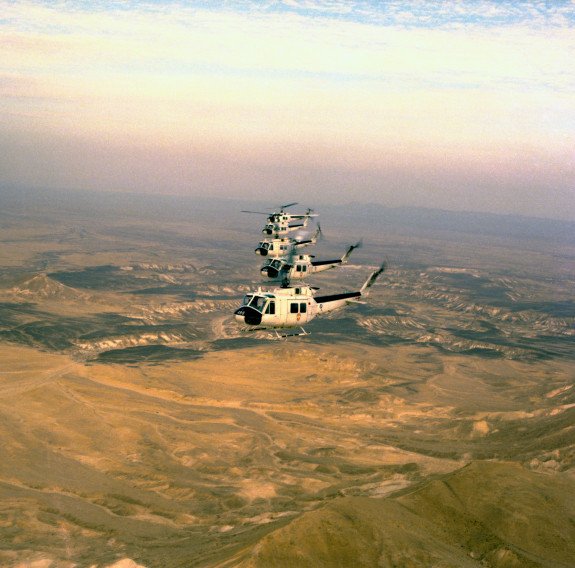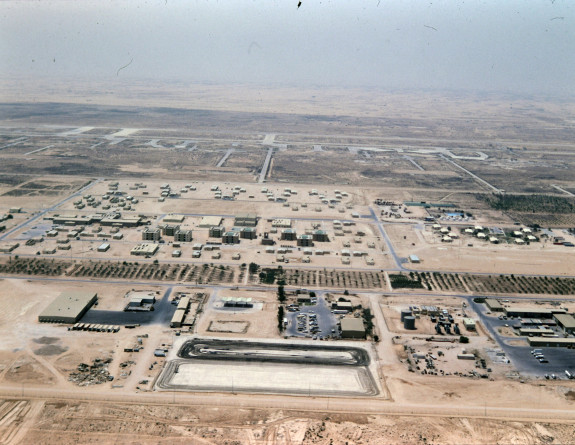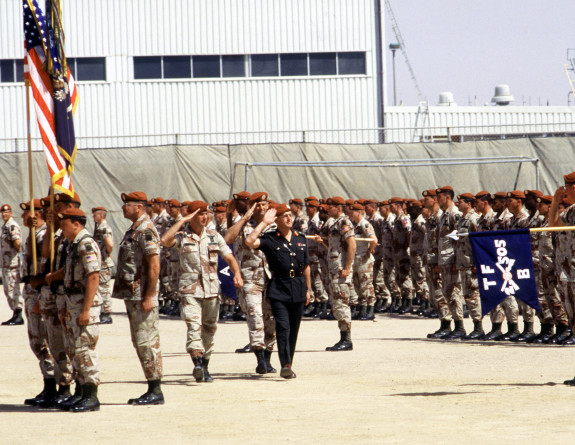Anzac Day marks 40 years of NZDF service in Sinai
On Anzac Day 40 years ago, the New Zealand Defence Force began contributing to international peacekeeping force the Multinational Force and Observers (MFO) on the Sinai Peninsula.
22 April, 2022
Thirteen nations contribute to the MFO, which continues to oversee the terms of the 1979 peace treaty between Egypt and Israel. This is accomplished in a number of ways including by operating checkpoints, observation posts and carrying out patrols.
It is the NZDF’s second longest-running overseas deployment outside of support to Antarctic operations.
In his book In the Field for Peace, NZDF historian John Crawford described New Zealand’s initial contribution to the MFO of two Iroquois helicopters, leased from the United States, and personnel to an ANZAC unit that operated the MFO’s helicopters. The contingent comprised 36 Royal New Zealand Air Force and NZ Army personnel, who crewed and maintained the helicopters or served in the MFO headquarters.

Air to air view of a formation of Iroquois helicopters operated by RNZAF pilots as part of the Multinational Force and Observers mission in Sinai.
Two Multinational Force & Observers Iroquois on the ground.
In an account of the NZDF’s history at the MFO, Steve Moore, a Flying Officer in the initial deployment, described the main MFO camp when they arrived.
The North Camp hadn’t been completely built when they had arrived, he had recalled.
“It had been an Israeli Air Force base. The MFO was left with a shell – the Israelis blew up the underground hangars, took the wiring out of the houses, and even took the trees out of the ground.’’
Because initially there had not been hangars for the helicopters, the maintenance was done out of a tent.
The primary tasks of the New Zealand contingent at the MFO today are to provide a force training team and a transport section.
Peter Sheppard was a Warrant Officer who served with the MFO in 1983. He once described how New Zealand came to provide driving instructors.
There had been a high number of MFO vehicle accidents in the first 12 months of operating, and the MFO headquarters had asked contributing nations for training support.
He had recounted how the NZ Army had responded by offering a five-man driver training team who would spend time in the Sinai identifying deficiencies in driver training, and establishing an ongoing driver development programme to reduce motor vehicle crashes.
When the ANZAC helicopter unit completed duties in March 1986, New Zealand agreed to provide personnel for the MFO headquarters as well as a Training and Advisory Team.
The late Lieutenant General Don McIver was the MFO Force Commander 1989-1991 and in 2012, when the MFO’s 30th anniversary was marked, described the Sinai as “a place of interesting contradictions.”
“There were times when we were confronted with issues with very serious implications for the Force, while on the other hand there were times when it was important to make the best of the opportunity to relax,” he said at the time.
The First Gulf War had presented a very real threat to the MFO, with the North Camp and some remote sites within range of Saddam Hussein’s Scud missiles. Force protection was upgraded, and each time Scuds were launched towards Israel, MFO staff in the likely target zones took cover. Fortunately, the closest a Scud came to an MFO installation was about 32kms away, in the Negev Desert.
On 26 April 2006, Lance Corporal Joshua Roewen was the driver of an MFO vehicle with four passengers that was attacked by a suicide bomber.
The explosion damaged the windshield, a window and blew out both tyres on the right-hand side of the vehicle.
Despite that, Lance Corporal Roewen continued to drive for more than a kilometre, radioing the Force Operations Centre to report the incident, before parking the vehicle in a safe spot and establishing initial security to the area.
In recognition of his demonstration of the NZ Army’s core values of courage and commitment, Lance Corporal Roewen was awarded a Chief of Defence Force Commendation.


Multinational Force & Observers hilltop observation post (left) and base in Sinai Peninsula (middle). Lieutenant General D. S. McGiver, center, commander MFO, and two officers from the 82nd Airborne Division salute (right).
Today, the core New Zealand contingent is made up of 28 personnel, although the NZDF also has others involved.
The current Force Commander is New Zealand Army Major General Evan Williams, and two NZDF personnel fill positions supporting the Force Commander.
In the Sinai, roles filled by NZDF personnel during their deployments range from force protection analysts, to passport clerks, engineer officers, a chief instructor and instructors, physical training instructors, drivers and driving instructors, section commanders, and electricians.
This year the NZDF has also deployed five NZ Army engineers for six months, where they are increasing storm water protection at the MFO’s South Camp.
The Senior National Officer for the current New Zealand contingent, Lieutenant Colonel Kevin Williams, said the work of NZDF personnel in the MFO was as relevant today as it was 40 years ago.
“We’re part of a multinational force that ensures the provisions of the peace treaty, agreed to by Egypt and Israel, are adhered to.
“It’s a unique working environment in the Sinai. It can be hot and dusty, but it’s rewarding to be working alongside military personnel from all over the world, carrying out roles that enable this peacekeeping mission to function and endure,” he said.
“The MFO is one of the most successful commitments to peace in the Middle East, and is unique by not being a United Nations mission. Forty years of peace between Egypt and Israel is an amazing achievement considering the wars between these two countries in 1956, 1967 and 1973.
“On Anzac Day, we’ll be remembering all those who have served, and taking a moment to reflect on the NZDF’s 40 years of service at the MFO.”